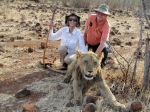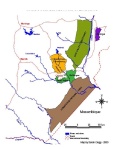 This blog will now become inactive. One year ago on Oct 23, 2012 we began our trip to South Africa, a trip of a lifetime. This blog was initially set up to capture an electronic copy of my travel journal, and as a place to keep track of our trip pictures in Smilebox slideshows. Then it evolved. Upon returning home, I continued my Google newsfeeds from South Africa and Zimbabwe and watched fascinated as Zimbabwe approached and passed through the election process largely without violence. I also watched the reports of Mandela’s most serious fight with life threatening illness in the summer of 2013, as I am sure that South Africa will change considerably in a post-Mandela world. I captured links to the news items that caught my attention from Feb. 2013 until Oct. Articles about wildlife or travel in SA and Zim became new blog posts. Other news items of interest were referenced and linked in the NewsSA and NewsZim pages attached to this blog. That process will also stop now.
This blog will now become inactive. One year ago on Oct 23, 2012 we began our trip to South Africa, a trip of a lifetime. This blog was initially set up to capture an electronic copy of my travel journal, and as a place to keep track of our trip pictures in Smilebox slideshows. Then it evolved. Upon returning home, I continued my Google newsfeeds from South Africa and Zimbabwe and watched fascinated as Zimbabwe approached and passed through the election process largely without violence. I also watched the reports of Mandela’s most serious fight with life threatening illness in the summer of 2013, as I am sure that South Africa will change considerably in a post-Mandela world. I captured links to the news items that caught my attention from Feb. 2013 until Oct. Articles about wildlife or travel in SA and Zim became new blog posts. Other news items of interest were referenced and linked in the NewsSA and NewsZim pages attached to this blog. That process will also stop now.
You see, I feel like this blog is finished. So, let me wrap this up with a few parting comments:
- if you have the opportunity to go to South Africa, do so. It’s amazing.
- go for as long as you can afford
- if Victoria Falls is an option, take it. Beware of other parts of Zimbabwe as the situation there appears to be unstable and deteriorating as of Oct. 2013.
- be an informed traveler. Set up Google news feeds and watch what is reported. Also watch the website AllAfrica.com . Recognize that news reports tend to sensationalism or on occasion government propaganda. Nonetheless, it will create a context. Likewise, look for current blogs. Visit the Thorntree forum.
- learn to say unjani (how are you) and siya peela (I’m fine). It’s Zulu. It’s understood just about everywhere we went and it always brought up smiles.
- here’s the final answer to the question, “Would you do it again?” Yes, in a heartbeat.
Best wishes to you for safe travels. Cheers from Vancouver Island on the west coast of Canada where we only have black bears, cougar and wolves. Jim.





